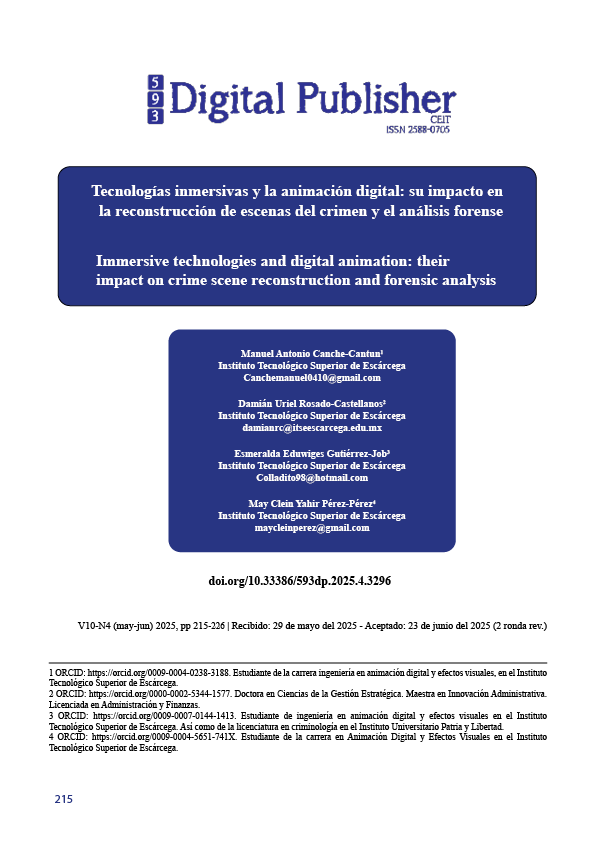Tecnologías inmersivas y la animación digital: su impacto en la reconstrucción de escenas del crimen y el análisis forense
Contenido principal del artículo
Resumen
La animación digital y las tecnologías inmersivas están transformando significativamente la criminalística, ofreciendo herramientas innovadoras para la reconstrucción de escenas del crimen, el análisis de evidencias y la presentación de pruebas en procesos judiciales. Este estudio, basado en una revisión sistemática con metodología PRISMA, analiza treinta investigaciones recientes que abordan el uso de tecnologías como la animación criminalística, la realidad aumentada, la tecnología 3D, la fotogrametría, las evidencias digitales y la inteligencia artificial en el ámbito forense. Los resultados muestran una tendencia creciente hacia la adopción de estas herramientas digitales, destacando la realidad aumentada, las evidencias digitales y la animación como las más aplicadas para la visualización y comprensión de los hechos. Si bien cada tecnología presenta ventajas y limitaciones específicas, su integración conjunta optimiza las investigaciones, haciendo el trabajo pericial más accesible, rápido y claro para jueces, fiscales y otros actores del sistema judicial.
Descargas
Detalles del artículo

Esta obra está bajo una licencia internacional Creative Commons Atribución-NoComercial-CompartirIgual 4.0.
1. Derechos de autor
Las obras que se publican en 593 Digital Publisher CEIT están sujetas a los siguientes términos:
1.1. 593 Digital Publisher CEIT, conserva los derechos patrimoniales (copyright) de las obras publicadas, favorece y permite la reutilización de las mismas bajo la licencia Licencia Creative Commons 4.0 de Reconocimiento-NoComercial-CompartirIgual 4.0, por lo cual se pueden copiar, usar, difundir, transmitir y exponer públicamente, siempre que:
1.1.a. Se cite la autoría y fuente original de su publicación (revista, editorial, URL).
1.1.b. No se usen para fines comerciales u onerosos.
1.1.c. Se mencione la existencia y especificaciones de esta licencia de uso.
Citas
Pulgar, H. Mera, D Alcocer, E. & Carrasco, M. (2024). Reconstrucción virtual como técnica de recreación de prototipos en evaluaciones de escenas del crimen: Una revisión bibliográfica. La Ciencia al Servicio de la Salud y Nutrición, 15(1), 160 169. https://doi.org/10.47187/cssn.Vol15.IssEd.Esp.313
Villa, C. Lynnerup, N. & Jacobsen, C. (2023). A virtual, 3D multimodal approach to victim and crime scene reconstruction. Diagnostics, 13, 2764. 10.3390/diagnostics13172764
Ebert, L. Franckenberg, S., & Sieberth, T. (2021). A review of visualization techniques of post-mortem computed tomography data for forensic death investigations. International Journal of Legal Medicine, 135, 1855–1867. 10.1007/s00414-021-02581-4
Abdullah, K. & Laghari, A. (2021). Digital forensics. Journal of Digital Investigations, 15(3), 45-59. 10.1504/ijesdf.2022.10037882
Rodríguez , J. (2021). Reconstrucción virtual como técnica de recreación en una escena del delito en las investigaciones criminalísticas en Panamá. Revista de Criminalística y Justicia, 15(2), 112-128. https://repositorio.umecit.edu.pa/handle/001/6424
Mayne, R. & Green, H. (2020). Virtual reality for teaching and learning in crime scene investigation scene investigation. Journal of Applied Technology and Innovation, 10.1016/j.scijus.2020.07.006
Zechner, O. Kleygrewe, L., Jaspaert, E., Schrom, H., Hutter, V., & Tscheligi, M. (2023). Enhancing operational police training in high-stress situations with virtual reality: Experiences, tools, and guidelines. Multimodal Technologies and Interaction, 7, 14. https://doi.org/10.3390/mti7020014
Leonard, J. (2024). A picture is worth a thousand words: Effective use of storytelling and visualization in forensic investigations and construction litigation. Journal of Forensic Engineering and Construction Litigation, 15(2), 123-135. https://doi.org/10.1061/9780784485798.023
Reichherzer, C. Cunningham, A & Coleman, T. (2021). Bringing the jury to the scene of the crime: Memory and decision‑making in a simulated crime scene. Proceedings of the 2021 CHI Conference on Human Factors in Computing Systems. 1 - 12 https://doi.org/10.1145/3411764.3445464
Meshal, A. Hoshang, K. & Ramy H (2024).Designing and evaluation of a mixed reality system for crime scene investigation training: a hybrid approach. Virtual Reality 28, 127. https://doi.org/10.1007/s10055-024-01018-8
Ramallal, P (2021). Realidad virtual en la recreación de escenas de crimen como complemento formativo en los estudios de derecho criminalístico. Revista de Derecho y Tecnología Forense, 10(2), 45-59. 10.13140/RG.2.2.13463.50086
Omowunmi, E (2022). 3D Forensic Crime Scene Reconstruction Involving Immersive Technology: A Systematic Literature Review. International Journal of Forensic Technology, 14(2), 67-82. 0.1109/ACCESS.2022.3199437
Minhua, M. & Hairu, Z (2023). Virtual Reality and 3D Animation in Forensic Visualization. Journal of Forensic Research and Technology, 18(3), 120-135. 10.1111/j.1556-4029.2010.01453.x
Rachael, M. (2021). 3D forensic science: A new field integrating 3D imaging and 3D printing in crime reconstruction. Forensic Science Review, 33(4),250-264. 10.1016/j.fsisyn.2021.100205
Martinez, M. X. (2022). Uso de levantamientos topográficos como apoyo para la investigación y reconstrucción de accidentes de tránsito. Recuperado de: http://hdl.handle.net/11349/31389
Pardo Salazar, J. & Vitola, J (2023). Aplicación de las fases del análisis forense digital simulando una escena del crimen denominada El hacker Asesino. Revista los libertadores 3(1), 45-58. recuperado de: http://hdl.handle.net/11371/5950
Malik, S. N., Chee, M. H., Perera, D. M. A., & Lim, C. H. (2024). Feasibility of neural radiance fields for crime scene video reconstruction. Journal of Forensic Engineering and Technology, https://doi.org/10.48550/arXiv.2407.08795
Puche, O. J., Valencia, J. L., & Cervantes, L. C. (2024). Impacto del uso del polígono virtual en la formación del futuro oficial de la Policía Nacional de Colombia. Revista Logos Ciencia & Tecnología, 16(3), 148–167. https://doi.org/10.22335/rlct.v16i3.1882
Espinoza, M. (2020). Informática forense: una revisión sistemática de la literatura. Revista ciencia humanística y sociales, 1(1), 15-30. https://doi.org/10.33936/rehuso.v4i2.1641
Barquero Morales, W. G. (2022). Análisis de Prisma como Metodología para Revisión Sistemática: una Aproximación General. Saúde Em Redes, 8(sup1), 339-360. https://doi.org/10.18310/2446-4813.2022v8nsup1p339-360
Wheeler, J., Hartley, J., & Craig, R. (2023) The impact of computer animation presented in civil versus criminal trials. The Keystone Journal of Undergraduate Research, 9(1), 1–12. rescatado de: https://www.ship.edu/academics/student-research/keystone-journal/volumes/
Antonio, S. (2020). Forensic technologies in the courtroom: A multi-disciplinary analysis. In Forensic Technology Applications (pp. 1-22). 10.4018/978-1-7998-3025-2.ch020
Emma, R. & Tara, M. (2022). Technology on trial: Facilitative and prejudicial effects of computer-generated animations on jurors’ legal judgments. Psychology, Crime & Law, 28(8), 720–740. https://doi.org/10.1080/1068316X.2022.2041014
Natalya, I. (2022). Application of 3D technology in criminal proceedings. European Proceedings of Social & Behavioural Sciences, 2022, 557–564. https://doi.org/10.15405/epsbs.2022.01.66
Ragni, C. (2023). Digital evidence in international criminal proceedings and human rights challenges. European Criminal Law Review, 12(3), 327–348. https://doi.org/10.25234/eclic/28255
Irene, A. & Gianmarco, B.(2021). Image and video forensics. MDPI Editorial. 7(11), 242 https://doi.org/10.3390/jimaging7110242
Law, B. (2020). 3D scanning as a way of fixing a crime scene: Advantages and disadvantages. ResearchGate. 343.98:02 10.32850/LB2414-4207.2020.16.01
Nea, E. (2021). Animating truth. Edinburgh University Press. Rescatado de; https://library.oapen.org/handle/20.500.12657/46536
Jamie, K. & Adam, J. (2022). Extended reality (XR) virtual practical and educational eGaming to provide effective immersive environments for learning and teaching in forensic science. Science & Justice, 62(6), 388-399. 10.1016/j.scijus.2022.04.004
Luca, T. & Thierry, H. (2021). Virtual reality (VR) in forensic psychology: Interests and issues in research and practice. ResearchGate. Rescatado de: https://hal.univ-lille.fr/hal-04302637v1
Luisa, V. (2020). Media forensics and deepfakes: An overview. arXiv Preprint. vol. 15, pp. 620–634 https://doi.org/10.48550/arXiv.2001.06564
Akos, D. & Raffael, G. (2023). Augmented reality in forensics and forensic medicine: Current status and future prospects. Journal of Forensic Sciences, 68(5), 1452–1464.10.1016/j.scijus.2023.04.009
Vahid, P; Maxime, C. & Lonni, B (2024). Collaborative forensic autopsy documentation and supervised report generation using a hybrid mixed-reality environment and generative AI. PubMed. 7452 - 7462 10.1109/TVCG.2024.3456212
Nathan, R. & Heike, H.Smith, B., & Martinez, P. (2025). Interactive visualization framework for forensic bullet comparisons. arXiv Preprint. 2503.05910 https://doi.org/10.48550/arXiv.2503.05910
Merel, L. & Javier, L. (2024). ProtoExplorer: Interpretable forensic analysis of deepfake videos using prototype exploration and refinement. ResearchGate. Vol(23) 10.1177/14738716241238476
Snehalata, U. & Varad, N. (2023). Artificial intelligence-based techniques for crime scene reconstruction and investigation: An overview. Hilaris Publishers. Ed(14). Recuperado de: ISSN: 2157-7145
Xavier, C. & Omar, F.. (2024). Technology in forensic sciences: Innovation and precision. MDPI. 12(8), 120 https://doi.org/10.3390/technologies12080120
Jae, U. & Woo, Y. (2020). Comparative análisis on integrated digital forensic tools for digital forensic investigation. ResearchGate. 834 (34) 10.1088/1757-899X/834/1/012034
Sandra, J. R. & Cesar, C. C. (2024).Simulación de la escena de crimen: Un enfoque novedoso para la enseñanza de la medicina forense. Vita et Scientia, 10(2), 45–60. Rescatado de: https://revistas.uniandes.edu.co/index.php/vys/article/view/9125/9585
Zappalà, A., Guarnera, L., Rinaldi, V., Livatino, S., & Battiato, S. (2024). Enhancing crime scene investigations through virtual reality and deep learning techniques. arXiv, 2409.18458v1. https://arxiv.org/abs/2409.18458
Carew, R. & David, E. (2020). An overview of 3D printing in forensic science: The tangible third-dimension. Journal of Forensic Sciences, 65(5), 149-1752. https://doi.org/10.1111/1556-4029.14442
Albeedan, M., Kolivanda, H., & Hammady, R. (2024). Designing and evaluation of a mixed reality system for crime scene investigation training: a hybrid approach. Virtual Reality, 28, artículo 127. https://doi.org/10.1007/s10055-024-01018-8
La Cava, S. M., Orrù, G., Drahansky, M., Marcialis, G. L., & Roli, F. (2023). Reconstrucción facial 3D: el camino hacia la ciencia forense. ACM Comput. Surv. 56, 3, Article 77 https://doi.org/10.1145/3625288
Nicho, M., Alblooki, M., AlMutiwei, S., McDermott, C. D., & Ilesanmi, O. (2023). A Crime Scene Reconstruction for Digital Forensic Analysis: An SUV Case Study. International Journal of Digital Crime and Forensics, Vol(15) 10.4018/IJDCF.327358
Malik, S. N., Chee, M. H., Perera, D. M. & Lim, C. H. (2024). Feasibility of Neural Radiance Fields for Crime Scene Video Reconstruction. arXiv preprint, 08795v1 https://doi.org/10.48550/arXiv.2407.08795
Barbe, H., Müller, J. L., Siegel, B., & Fromberger, P. (2022). An Open Source Virtual Reality Training Framework for the Criminal Justice System. Criminal Justice and Behavior, vol(50) https://doi.org/10.1177/00938548221124128
Carew, R. M., French, J., & Morgan, R. M. (2023). An ethical framework for the creation and use of 3D printed human remains in crime reconstruction. Forensic Science International: Reports, 7, 100319. https://doi.org/10.1016/j.fsir.2023.100319
Rengifo, C. C. (2023). La animación tridimensional computarizada y su utilidad criminalística en la reconstrucción del hecho punible. Revista “Lic. Miguel José Sanz”, Vol. 1, Nro. 1, pp. 29–45. Universidad de Carabobo, Venezuela. Rescatado de: ISSN-e: 3006-2608
Peña, A. F., Salcedo, J. M., Alvarez, J. L. Hoyos, E., & Diaz, E. R. (2024). La Inteligencia Artificial en la Lucha Contra el Crimen Organizado. Ciencia Latina Revista Científica Multidisciplinar, 8(4), 2144–2158. https://doi.org/10.37811/cl_rcm.v8i4.12455
Céspedes, N. E., Cervantes, L. C., & Fonseca, L. Y. (2023). Realidad Aumentada como Recurso de Formación en las Fuerzas Militares Caso Policial - Escuela de Cadetes General Santander / Augmented Reality as a Training Resource in the Military Forces: A Police Case. Revista Colombiana de Tecnologías de Avanzada, 1(41), 66–78 https://doi.org/10.24054/rcta.v1i41.2419





